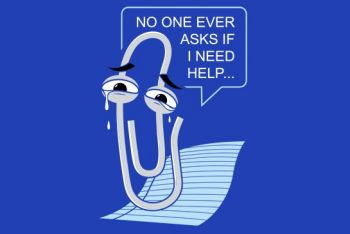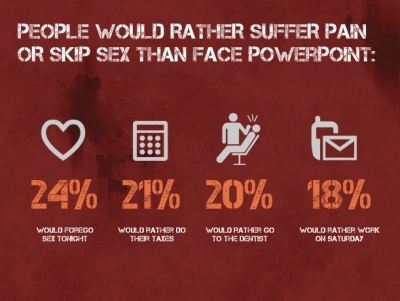
It’s a widely cited fact, and to me, an unbelievable one: most Americans cite their biggest fear, by a wide margin, as speaking in public. Beyond the incredible insularity and egocentrism of this perspective (because Raiders fans, Anne Coulter and clowns do not, apparently, crack the top 10, and I find these infinitely more terrifying). But apparently, this is what gets our collective psyches in a tizzy – the thought of having to stand before a crowd and give a presentation.
In a 2012 Gallup poll, the fear of public speaking is apparently at its greatest in a business-related setting, particularly when a superior is present (maybe because people don’t realize that HR is, in fact, spying on their Facebook accounts).
A quick Google search reveals a cottage industry sprung up around overcoming this seemingly insurmountable obstacle of verbal communication, from self-help books to hypnotherapy to ready-to-purchase templates for speeches on every subject imaginable – not to mention SlideShare, the ultimate low-impact source for hitting the decks.
Apparently, Valium just doesn’t cut it these days.
Of course, those petrified by presenting at a meeting or business function neglect some self-evident facts. No one really listens to what you have to say (most are thinking about how much better they could put this lost time to use) and no one wants to be there (unless, of course, it’s a lunch meeting, but after the turkey sandwich is gone, they want to be there even less). Minds wander (particularly if the speaker is more attractive than their spouse or if they abandoned an online sudoku game just prior to the meeting), and those who actually have a pen out are most likely doodling, making a shopping list, or writing an elaborate suicide note, depending on the meeting’s topic and length.
Of course, in my corporate experience, most meetings are actually just to schedule other meetings or clarify previous meetings. This is, on the fun scale, slightly above bubonic plague yet slightly below CSPAN. At least those meetings have real-world repercussions. The average corporate meeting is about as mundane and forgettable as a Merchant-Ivory flick.
But not for the poor guy who actually has to speak. This is life or death. Everyone’s watching, hanging on his or her every word, and come performance review time, this will be the primary indicator of whether that raise is going to happen this year or not. But fortunately, he has a little trick up his sleeve. A kick-butt PowerPoint deck, ready and rearin’ to go.
This is how people compensate for their fear of public speaking; they completely negate having to do it. Why draw attention to yourself when you can easily divert all eyes towards the screen? Why would write a speech when you can neatly present it in bullet points set nicely against an earth-toned backdrop with fun fonts? And why unnecessarily risk losing your place or misspeaking when you can simply read from the screen verbatim?
When PowerPoint was first introduced, it was billed as a way to neatly underscore your main points while making a presentation stand apart (or so the little friendly paper clip told me as he jumped across my screen). And what fun it was; by far the best product Windows ’95 had to offer, except perhaps the original Flight Simulator or Encarta.
Best of all, it was, in those halcyon days, kind of a well kept secret. You could formulate a great looking presentation in under twenty minutes and not everyone was hip to the fact that it was basically the business equivalent of a coloring book – kind of like Prezi is today (it’s got animation! Which was impressive in 1929!)
Now allow me to clarify. I hate PowerPoint. Passionately. I grit my teeth whenever I see that omnipotent slide projector sitting in the middle of a room, warming up. Because at that point in time, the entire purpose of my attendance, of physically being in that meeting, has just been extinguished. The next thirty minutes or two hours will involve systematically jumping from bullet point to bullet point (a device meant, originally, as a talking point to be expounded upon), while the speaker reads exactly what’s written on the screen. PowerPoint no longer supports presentations. It’s too often the presentation itself, a populist’s teleprompter.
The 3 Kinds of Powerpoint Users

There are three basic types of PowerPoint users that I have identified from hundreds of hours of observation:
1. The Drone:
Every slide is set up in the exact same Spartan fashion, with a corporate logo at the bottom and Times New Roman set against a white backdrop. They generally use the smallest bullet points and have the most content to go over. Coupling a monotone reminiscent of Steven Hawking with the speed of a Sotheby’s auctioneer, they read each slide verbatim, trying to get to the end of the slide show as quickly as possible, skimming over elaborate tables, charts and graphs that likely contain useful, pertinent information.
They only pause to catch their breath when the inevitable “Questions?” slide pops up, the universal signal for ‘thank God this thing is done with.’
And we know never to ask any. It’s like surviving the Bataan death march and asking to build another bridge, since you’re already there and all.
2. The Thespian: A variation on the drone, only this person enjoys being in front of a crowd, so they will take as much time as possible going through the talking points. This person is likely to include jokes, alternating transitions between every slide (because there’s nothing to underscore the importance of your presentation like a good star wipe) and as many colors as a Crayola sampler pack. They change fonts whenever possible (believing that Comic Sans is, indeed, subliminally comic), and the overall effect is like reading a ransom note, only slightly more unsettling.
This person will also read the slides word-for-word, but believe that they are fooling their audience by changing their vocal inflections in a completely unnatural and often strained manner, which almost always sounds like they’re reading “Goodnight Moon” to a roomful of kindergartners. The Thespian will also pause for laughter, even when none is readily apparent, and will not surrender the stage until the room applauds, at which point they often offer a broad bow/curtsey, believing this to be original.
3. The Fascist: The slide isn’t the Fascist’s primary concern. It is the fact that they are controlling the pace of the meeting, and that the huge drop-down projection screen is subordinate to their commands. They often pace across the stage, pausing dramatically in front of the projector so that their shadow is cast in silhouette, which they then admire before resuming. The Fascist almost never has the clicker to move between slides, yet has a subordinate hidden somewhere in the room so that they can yell “Next!” and lo, it will come to pass.
While their tone remains fairly consistent, they will alter the volume of their voice as necessitated by any bold or italicized text. For some reason, bold is always yelled in a booming vibrato, while italics are often enunciated softly, like a conspiratorial secret. This protocol was likely institutionalized in the … for Dummies oeuvre. When the Fascist is finished, they often stand onstage, smugly surveying the room, basking in the superiority that was their presentation.
PowerPoint is the perfect solution for a society weaned on thirty second commercials promising twenty-minute abs. A single slide offers maybe 30 words, three bullet points, and 10 seconds of reading material. Here’s what you should know, in sequence. There is no point to thinking about the content of the slide or challenge its veracity, because someone has already taken care of that. And there is no need to actively listen, because we are presented with a list of pertinent topics in the very first slide, and any deviation from this list would throw the entire enterprise completely out of whack. The last point always holds the promise of a “Q&A,” but there never seems to be any questions, only easy answers, spread out in bullet points.
PowerPoint is a disease, transmitted through b-schools and companies of all sizes, with an almost absolute rate of infection. Because on some dreadful, preordained moment, you will be the person in front of the room, and giving a presentation without PowerPoint is unthinkable. Because if you don’t have slides, do you really have anything important to say?
The answer is yes. And there is a cure. You want to make your presentation stand out? Really be remembered? Have the entire room hanging on your every word?
Do the entire thing without PowerPoint. Say what you’ve got to say. And I guarantee, for once, people might listen. It’s a revolutionary idea, but that’s what it takes to alter the status quo. Just think, if some courageous cubicle drone hadn’t worn jeans to work on a Friday, we’d still all be wearing suits and ties. And that would be almost as uncomfortable as sitting through a two hour long PowerPoint presentation. Almost.
 There are three basic types of PowerPoint users that I have identified from hundreds of hours of observation:
There are three basic types of PowerPoint users that I have identified from hundreds of hours of observation:Comment by Kelly Blokdijk on July 2, 2014 at 9:50pm
Comment by Mark Tortorici on July 10, 2014 at 1:39am
Comment by Kate Supino on March 5, 2015 at 6:40pm
![]()


You need to be a member of RecruitingBlogs to add comments!
Join RecruitingBlogs